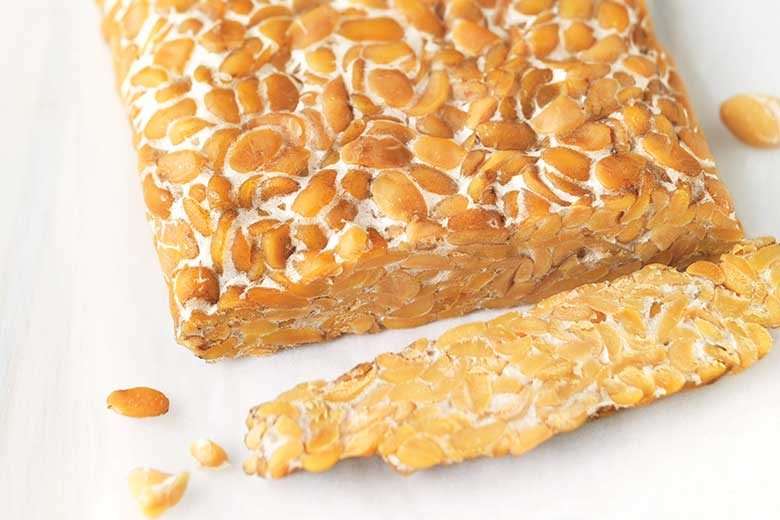
Tempeh versions of burgers, sloppy joes and meatloaf reflect an American spin on a centuries-old Indonesian staple. Extensively researched in the United States in the late 1950s, nutrient-rich tempeh — made from soybeans — began to be commercially produced by the early 1970s.
Densely connected by white filaments, rectangular-shaped tempeh looks like a slab of Italian nougat studded with soybeans instead of nuts. In a similar way that adding an edible mold to cheese creates Roquefort (a blue cheese), cooked soybeans ferment and bind together when exposed to a mold culture from the Rhizopus genus. Unlike anaerobic fermentation, tempeh requires a warm, oxygen-rich environment and can ferment within 24 hours.
While a block of fermented soybeans may not sound appealing, its versatility and nutrient density have created many tempeh fans.
In the Kitchen: Like tofu, tempeh’s high protein content makes it a natural meat substitute. Both absorb flavors of other ingredients well; however, soy-based tempeh and tofu aren’t close culinary substitutes. Tempeh’s dry, pressed form makes it densely compact to withstand slicing into strips for grilling, cubing for kebabs, grating for a stuffing or crumbling by hand to sauté. Tempeh also absorbs flavors of marinades and smokers well. Steaming or soaking tempeh in simmering water or broth for five to 10 minutes softens its texture and increases absorption of sauces or marinades.
In addition to soybeans, the Rhizopus culture can ferment a variety of beans and grains such as chickpeas, black-eyed peas, millet, flax, sorghum, corn, brown rice, barley and oats, which are included with some varieties of tempeh. Such ingredients influence the aroma and flavors of tempeh, which tend toward earthy, nutty, yeasty and mushroom-y.
Because tempeh is an unsalted, perishable and commercially produced food, cook it to 165 degrees Fahrenheit before eating. Pan-fry tempeh to brown and crisp its edges, or coat it in sauce and grill for sandwiches and wraps or to add texture to rice, quinoa and noodle dishes. Crumbled into hot oil, tempeh sautés well for a browned, ground-meat substitute to use in vegetarian chili, stroganoff and Bolognese or stuffed into empanadas or peppers.
In the Clinic: Denser than tofu, soy-based tempeh is more concentrated in macronutrients and calories. One 3-ounce serving of cooked tempeh (about ½ cup) contains approximately 166 calories, 10 grams of fat and 17 grams of protein. It also is a good source of iron and is a complete plant protein, providing adequate amounts of all nine essential amino acids. Soybeans are a source of prebiotics, which help to feed the beneficial bacteria found in the digestive tract.
Despite claims that tempeh acts like a probiotic, this is unlikely since the short fermentation period and cooking decrease lifespans of beneficial live bacteria.
Depending on the ingredients, tempeh varies in its fiber content and gluten-free status. Soy products can be high in phosphorus (a 3-ounce serving of cooked tempeh contains 215 milligrams), so people with kidney disease may need to limit the amounts of tempeh they eat.
In Quantity: As tempeh ages, several things can happen: It can develop grey and black spots; the white sections shrink; and the beans begin to darken. Such discolorations, while not attractive, may represent ripening and older stages of fermentation rather than spoilage. Discard tempeh if it develops bluish, pink or yellow colors, blackish beans, off odors or sticky, slimy textures.
While tempeh starter kits are available for making it at home, soy and whole-grain tempeh options are available in the refrigerated section of most grocery stores near vegetarian products such as tofu. Natural-food stores may offer other tempeh varieties such as smoked or marinated. Properly wrapped tempeh can last two weeks in the refrigerator and six months in the freezer.
Child nutrition programs can diversify their menu options through new crediting guidelines developed by the U.S. Department of Agriculture’s Food and Nutrition Service. Depending on the ingredients, and as long as at least the minimum amounts are used and identified, schools may credit tempeh as a grain, vegetable or meat alternate. Soybean-based varieties or those made with other legumes may be credited ounce-for-ounce as a meat alternate.
References
Cantabrana I, Perise R, Hernandez I. Uses of Rhizopus oryzae in the kitchen. Intl J Gastronomy Food Sci. 2015;2(2):103-111. Accessed March 5, 2019.
Crediting Tempeh in the Child Nutrition Programs. USDA Food and Nutrition Service website. Published April 17, 2019. Accessed August 27, 2019.
Foster K. Here’s What You Should Know About Tempeh. The Kitchn website. https://www.thekitchn.com/what-is-tempeh-ingredient-intelligence-211181. Accessed February 19, 2019.
Herbst ST, Herbst R. The Deluxe Food Lover’s Companion. Hauppauge, NY: Barron’s Educational Series, Inc.; 2009:475.
Katz, SE. The Art of Fermentation: An In-depth Exploration of Essential Concepts and Processes from Around the World. White River Junction, VT: Chelsea Green Publishing; 2012:280.
McGee H. On Food and Cooking, The Science and Lore of the Kitchen. New York, NY: Simon & Schuster; 2004: 500.
National Nutrient Database for Standard Reference Release, April 2018. United States Department of Agriculture/National Agricultural Library website. 16174 Tempeh, cooked
Prebiotics and Probiotics: Creating a Healthier You. Academy of Nutrition and Dietetics website. Published February 27, 2018. Accessed March 5, 2019.
Shurtleff W, Aoyagi A. History of Soybeans and Soyfoods, 1100 B.C. to the 1980. Lafayette, CA: Soy Foods Center; 2007:2. Accessed February 19, 2019.
The Renal Diet—Phosphorus. UNC Kidney Center website. Accessed February 19, 2019.
Webster, A. Microbial Misconceptions: Fermented Foods. International Food Information Council website. Published December 7, 2017. Accessed February 19, 2019.
What’s New and Beneficial About Tempeh. The World’s Healthiest Foods website. Accessed March 5, 2019.





